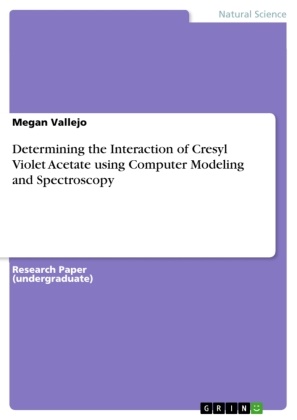Read more
Research Paper (undergraduate) from the year 2013 in the subject Chemistry - Organic Chemistry, Fairleigh Dickinson University, College at Florham, language: English, abstract: Science is always finding new innovative ways to help cure diseases like HIV, cancer, and Alzheimer's. Fluorescent dyes have been a way to trace certain genes within our DNA (deoxyribonucleic acid). It has been brought to our attention that cresyl violet acetate, an organic compound, stains blue when working with DNA, but stains purple when working with RNA. Cresyl violet also changes color based on differences in base pairing.With the increasing use of technology, computer modeling and spectroscopy have been used to analyze the interaction of cresyl violet when bound to DNA. The Molecular Operating Environment (MOE) computer modeling software was used to predict possible modes of interaction. The results were fairly constant, showing backbone interactions with the amine groups of cresyl violet. There was also hydrogen bonding predictions between cresyl violet and DNA. Intercalation, or pi-pi stacking was only predicted for adenine ssDNA with cresyl violet. Cresyl violets cationic character, allowed for pH to play a factor in its binding ability, and therefore it was determined that pH held at 7.2 - 7.4 were the best conditions. Dimerization was controlled using both low concentrations of cresyl violet and Gamma-cyclodextrin. By tracing pH and dimerization we can compare results to docking. This is since docking was set for cresyl violet with a +1 charge and with monomers docking to the DNA.Scatchard plot analysis showed that binding constants are affected by concentration of cresyl violet, and the inhibition of electrostatic interactions and dimerization. The lower the concentration, the less binding because of free versus bound ligand availability. At high concentrations, dimerization is too high, inhibiting binding. The use of spermidine to prevent electrostatic interactions, proved to improve binding of cresyl violet to DNA. Gamma-Cyclodextrin sequesters dimerization, which also improved number of binding site. This could suggest intercalation as a possible mode of interaction because more binding is present when both interactions are unavailable, however, more experimentation is needed to conclude that intercalation is in fact present.

